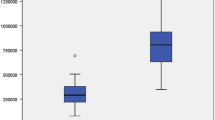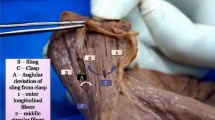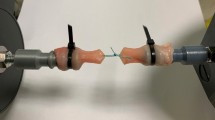Abstract
The phrenico-esophageal ligament (PEL), which is claimed by some to be an important anti-reflux barrier, has been accepted as an important structure by some surgeons dealing with the surgical treatment of hiatal hernias. However, the characteristics of its anatomical structure and the physiological importance of this ligament is still a subject of discussion. The aim of this study was to define this anatomic structure and to point out the clinical importance of the PEL. This study has been carried out on samples taken from 2 fresh and 12 fixed cadavers. The PEL was observed to be derived from the transversalis and endothoracic fascia attaching the esophagus to the diaphragmatic crura at the region of the esophageal hiatus. While the transversalis fascia covered the inferior surface of the diaphragm, it was observed to divide into upper and lower leaflets when it approached the esophageal hiatus. The endothoracic fascia turned superiorly at the level of esophageal hiatus and attached on to the esophagus by uniting with the upper leaflet of the transversalis fascia in 11 of the specimens. In three of the specimens, it attached on the esophagus at a higher level than the transversalis fascia. The histologic sections of our study revealed that the PEL is formed by collagen and elastic fibers composed of fibroblasts and blood vessels. Since the PEL is a strong structure that firmly attached to the esophageal wall and surrounded the upper part of the distal esophagus like a skirt, it is reasonable that it may play an important role in the gastroesophageal sphincteric mechanism. Histological evidence for decrease in collagen fibers with age and the loose arrangement of the elastic fibers due to this decrement might decrease the resistance and the elasticity of the PEL. This situation may explain the predisposition to hiatal hernias seen with increased in age.








Similar content being viewed by others
References
Bombeck CT, Dillard DH, Nyhus LM (1966) Muscular anatomy of the gastroesophageal junction and role of phrenoesophageal ligament; autopsy study of sphincter mechanism. Ann Surg 164:643–654
Boyce GA, Boyce HW (1999) Esophagus: anatomy and structural anomalies. In: Yamada T, Alpers DH, Laine L, Owyang C, Powell DW (eds) Textbook of gastroenterology, 3rd edn. Lippincott Williams & Wilkins, Philadelphia, pp 1180–1185
Bremner CG, Schlegel JF, Ellis FH (1970) Studies of the “gastresophageal sphincter mechanism”: the role of the phrenesophageal membrane. Surgery 67:735–740
Bremner CG, Shorter RG, Ellis FH (1970) Anatomy of feline esophageus with special reference to its muscular wall and phrenesophageal membrane. J Surg Res 10:327–331
Daniels BT (1965) The phrenesophageal membrane. Am J Surg 110:814–817
Davis EDD (1953) The anatomy and physiology of the cardiac end of the oesophageus applied to hiatal hernia and achalasia. J Laryngol Otol 67:139–152
Delattre JF, Palot JP, Ducasse A, Flament JB, Hureau J (1985) The crura of the diaphragm and diaphragmatic and treatment. Applications to gastroesophageal reflux, its investigation and treatment. Anat Clin 7:271–283
Delattre JF, Avisse C, Marcus C, Flament JB (2000) Functional anatomy of the gastroesophageal junction. Surg Clin North Am 80:241–260
Delmas A, Roux J (1938) Les gaines de l’oesophage diaphragmatique. Ann Anat Pathol 15:635–640
Delmas A, Roux J (1938) Le canal diaphragmatique de l’œsophage. Bull Assoc Anat 47:1–8
Demeter P, Pap A (2004) The relationship between gastresophageal reflux disease and obstructive sleep apnea. J Gastroenterol 39:815–820
Dillard DH (1964) Esophageal sphincter and reflux. Surg Clin North Am 44:1201–1209
Eliska O (1973) Phreno-esophageal membrane and its role in development of hiatal hernia. Acta Anat 86:137–150
Fenoglio-Preiser CM, Noffsinger AE, Stemmermann GN, Lantz PE, Listrom MB, Rilke FO (eds) (1999) The normal anatomy of the esophagus. In: Gastrointestinal pathology: an atlas and text, 2nd edn. Lippincott-Raven, New York, pp 15–29
Gambarelli J, Richelme H, Guerinel G, Dor V, Dahl C (1953) A propos de la membrane phréno-oesophagienne. Bull Assoc Anat 625–636
Hayward J (1961) The lower end of oesophageus. Thorax 16:36–41
Hayward J (1961) The phreno-esophageal ligament in hiatal hernia repair. Thorax 16:41–45
Hill LD, Tobias J, Morgan EH (1966) Newer concepts of the pathophysiology of hiatal hernia and esophagitis. Am J Surg 111:70–79
Hill LD, Aye RW, Ramel S (1990) Antireflux surgery: a surgeon’s look. Gastroenterol Clin North Am 19:745–775
Kierszenbaum AL (ed) (2002) The connective tissue. In: Histology and cell biology an introduction to pathology. Mosby, St. Louis, pp 95–98
Kwok H, Marriz Y, Al-Ali S, Windsor JA (1999) Phrenesophageal ligament revisited. Clin Anat 12:164–170
Loukas M, Louis RG Jr, Childs RS (2006) Anatomical examination of the recurrent artery of Heubner. Clin Anat 19:25–31
Michelson E, Siegel CI (1964) The role of the phrenico-esophageal ligament in the lower esophageal sphincter. Surg Gynecol Obst 118:1291–1294
Mittal RK (1990) Current concepts of the antireflux barrier. Gastroenterol Clin North Am 19:501–517
Ochsner JL, Hughes JP, Mills NL (1975) Repair of hiatal hernia: description and long-term results of a technique. Am Surg 41:629–631
Peters J, DeMeester TR (1999) Esophagus and diaphragmatic hernia. In: Schwartz SI, Shires GT, Spencer FC, Daly JM, Fischer JE, Galloway AC (eds) Principles of surgery, vol I, 7th edn. McGraw Hill International Edition, New York, pp 1081–1103
Skinner DB (1985) Hernias (hiatal, traumatic, and congenital). In: Berk JE (ed) Bockus gastroenterology, 4th edn. W.B. Saunders Company, Philadelphia, pp 705–716
Smith AB, Dickerman RD, Mcguire CS, East JW, Mcconathy WJ, Pearson HF (1999) Pressure-overload-induced sliding hiatal hernia in power athletes. J Clin Gastroenterol 28:352–354
Standring S, Ellis H, Healy JC, Johnson D, Williams A, Collins P, Wigley C (eds) (2005) Diaphragm and phrenic nerve. In: Gray’s anatomy, 39th edn. Churchill Livingstone, New York, pp 1081–1086
Zeifer HD (1967) Phrenesophageal-cardia-crural fixation in hiatus hernia repair. Am J Surg 114:480–481
Author information
Authors and Affiliations
Corresponding author
Rights and permissions
About this article
Cite this article
Apaydin, N., Uz, A., Evirgen, O. et al. The phrenico-esophageal ligament: an anatomical study. Surg Radiol Anat 30, 29–36 (2008). https://doi.org/10.1007/s00276-007-0279-0
Received:
Accepted:
Published:
Issue Date:
DOI: https://doi.org/10.1007/s00276-007-0279-0




